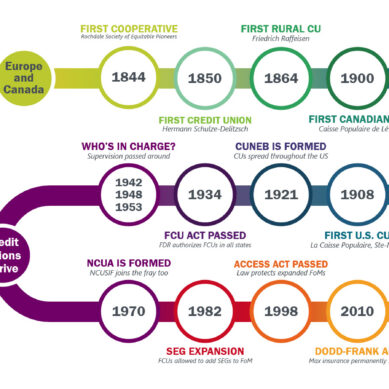In the financial services industry, it is crucial to understand the importance of a solid cybersecurity plan for maintaining business continuity, protecting member assets and data, and ensuring regulatory compliance.
But it’s not just about having the latest tech or the best experts on hand, it’s also about making sure all your cybersecurity efforts are in sync with your overall business goals. When you align your cybersecurity initiatives with what the credit union as a business aims to achieve, it’s not just a smart move—it’s a game-changer for growth and staying secure while hitting your desired outcomes.
Plan for changes
Effective cybersecurity is about more than just protecting assets. It is about enabling credit unions to thrive in a secure environment. Credit unions need to recognize that cybersecurity is not just an obligation to check off a list or tackle after a significant security event; it is a part of the process to successfully grow and advance.
Aligning cybersecurity with business objectives ensures that the security plan supports and enhances business goals. Think of aligning cybersecurity with business objectives like preparing a football team for a championship game. The team’s success relies on rigorous training, a strategic game plan, skilled players, and a clear objective.
However, if potential obstacles like players’ injuries and game-time decisions are not considered in the plan, the chances of losing the game increase significantly. By devising a strategy that accounts for these factors, the likelihood of victory is much greater. When cybersecurity is combined with business planning, it helps your credit union stay ahead of any potential threats and weaknesses that might get in the way of reaching your goals.
Getting the two in sync
When cybersecurity efforts aren’t synced up with the bigger goals of a credit union, it often leads to a patchwork of security measures that bad actors can easily exploit. This misalignment also means that resources might be wasted on overly protecting less critical assets while leaving the important ones exposed.
Plus, without a unified strategy, it’s tougher to spot, assess, and tackle risks effectively. These gaps make the credit union more vulnerable to cyber threats, threaten member trust, and can even lead to legal consequences if data breaches happen due to substandard security measures.
The Federal Insurance Deposit Corporation’s 2024 report on Cybersecurity and Resilience states, “According to the 13th Annual Ernst & Young (EY) Global Bank Risk Management Survey, cybersecurity risk was the top near-term risk for banks. Furthermore, the International Monetary Fund’s 2024 Global Financial Stability Report cited that extreme losses from cyber incidents are increasing, and such losses could potentially cause funding problems for targeted companies and even jeopardize their solvency.”
So, how can credit unions effectively align cybersecurity with their business objectives?
1. Conduct a comprehensive risk assessment
Begin with a thorough risk assessment that evaluates the potential cyber threats to the credit union. This involves identifying critical assets, understanding the threat landscape, and assessing the potential impact of different types of cyber incidents. A comprehensive risk assessment will inform the development of a cybersecurity strategy that aligns with business priorities.
2. Align security metrics with business KPIs
Develop security metrics that reflect business objectives. For example, if member trust is a key business goal, metrics related to data protection and privacy compliance should be prioritized. Regularly reviewing these metrics will provide insights into how well cybersecurity initiatives are supporting business outcomes.
3. Foster a culture of security
Cybersecurity should be ingrained in the company culture. This means educating employees about the importance of security and their role in maintaining it. Regular training sessions, awareness programs, and clear communication about security policies can help build a security-conscious workforce. When employees understand the relevance of cybersecurity to their daily tasks, they become active participants in safeguarding the credit union.
4. Collaborate across departments
Cybersecurity is not the sole responsibility of the IT department; it requires collaboration across the organization. Typically, departments within the same organization operate separately, rarely sharing insights or understanding issues that impact them similarly. Working in siloes hinders alignment, communication, and, ultimately, the security of the credit union. Breaking down siloes and building collaborative environments nurtures a united front and encourages regular, cross-functional teams to work together on security initiatives while achieving their business goals.
5. Invest in continuous, adaptable improvement
Cybersecurity is an ongoing process that requires regular evaluation and improvement. Conduct periodic security audits, penetration testing, and vulnerability assessments to identify and address weaknesses. Stay informed about the latest cybersecurity trends and technologies, and be prepared to adapt your strategies accordingly. Continuous improvement ensures that cybersecurity measures remain effective and aligned with evolving business objectives.
Work together across the organization
By taking a proactive and integrated approach to cybersecurity, credit unions can achieve their business targets while staying safe. Just like that same champion football team that requires seamless coordination and proactive strategy to win the game, cybersecurity needs the same level of integration and teamwork across the organization.
Each department plays a crucial role, contributing to the overall defense. It’s important to acknowledge that both business success and cybersecurity are linked, and one can’t succeed without the other because cybersecurity isn’t just an IT problem; it’s a must for any business. It touches every part of the organization, from earning member trust and following regulations to financial health and smooth operations.
Embracing a big-picture view of cybersecurity helps credit unions smoothly achieve their goals while keeping their operations secure.
























































